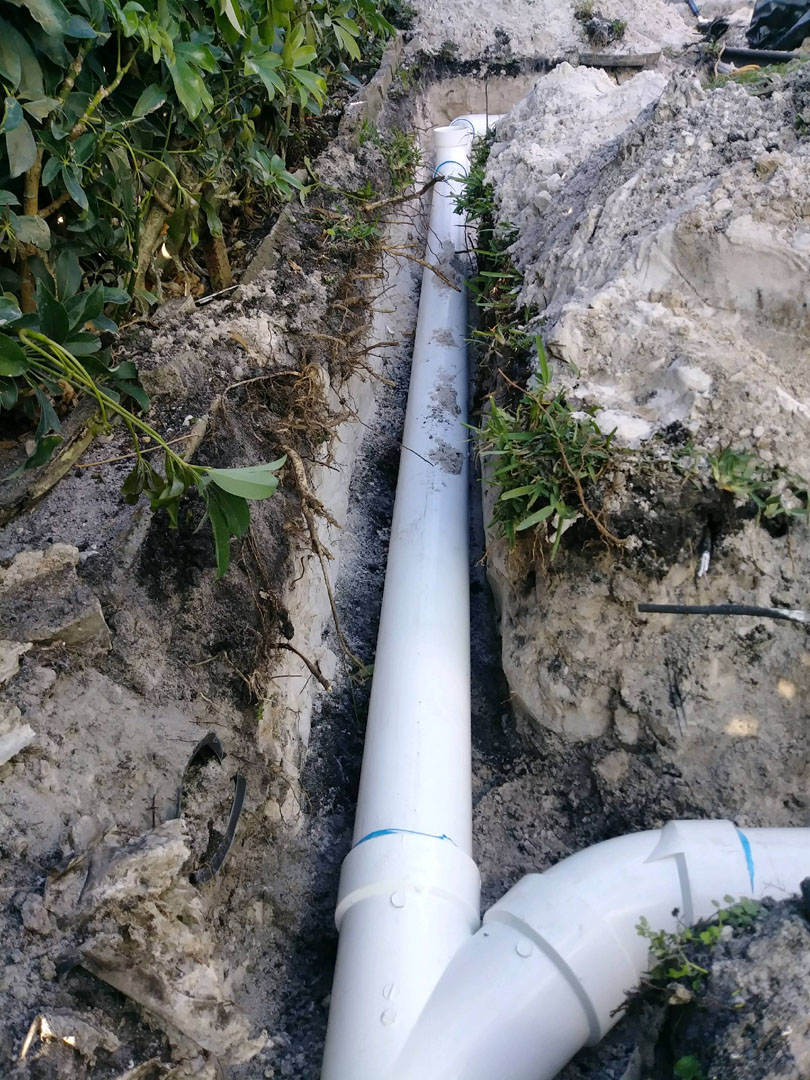How the drainage system works using your home’s gutters
Please Note : We do charge to come out for inspections for drainage proposals and the cost can vary depending upon your location. Centrally located in Palm Beach county typically $150. Beaches to borders of county $250 to $300. We can provide a free rough estimate if you are in our Palm Beach County, Florida service area and send your information we need of videos during a rainstorm & a property survey to us. Call us at 561 722 – 0252 for more information on this option.
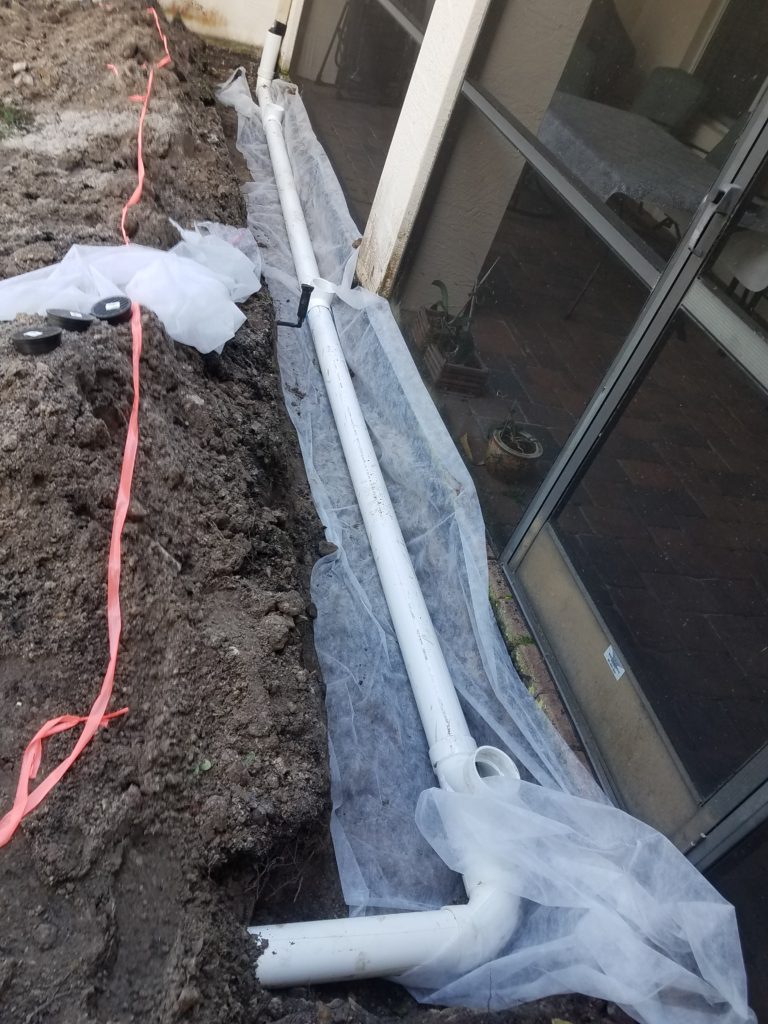
There are only a few ways that water will leave a property
First, the water will seep into the ground. If the water is not seeping into the ground in an unwelcome area, the soil may be too dense and not porous enough to get rid of the volume of water accumulating. A number of factors can contribute to this and if the water accumulates and quickly dissapates in minutes or even hours without a build up of mold or any damage to the home, this is a more favorable situation than many face with serious drainage problems.
If water is accumulating and mold or mildew is growing against the house or close to it, if water is entering into the home, this of course is a much more serious situation and people experiencing this may appreciate the following information.
The Second way that water leaves an area is by gravity. That is water will always go lower or downhill. If water is coming towards the home or building, there is a very high chance that the grade of the ground is off and guiding the water that way.
In some instances the grade can be changed and pitching the grade level to go lower away from the home. This is not always an option depending on the grade level of the home or buildings foundation, the contours of the property or neighboring properties which do not make this a viable option. Also, this can be quite expensive to remove not only the soil, re-pitch the grade, remove & re-install irrigation systems, but also re-place the landscape, variety of piping potentially in an area as well as the lawn, concrete, pavers, etc.
The Third way that water will leave an area is by force or pressure. Similar to when a pump turns on, that pump will push water. The force or strength of the water moving as it is pushed is called a ‘head pressure’. This is how your gutters on your home or building can help become a part of the solution to your drainage problem.
3 Questions every drainage solution should be able to answer
Question # 1 : How is the drainage problem water going to be collected?
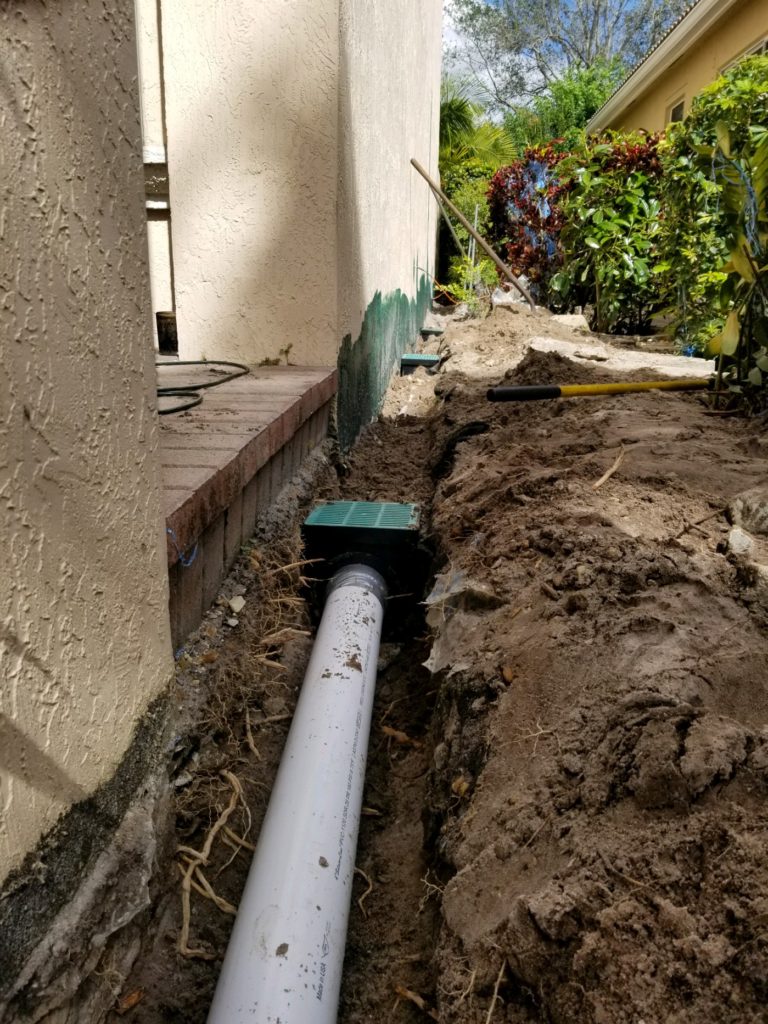
This part of the problem should be looked at carefully. Photos are good, but videos showing a large area of where the water is pooling during a very heavy rain can be most helpful in strategically placing the drains in the worst areas of where the water is pooling.
The grade of the property will show where the water is likely to be going and where it will rest, but during a rain the videos can show other elements as in how the water from adjacent areas or properties can be negatively influencing the problem.
The volume of water or if watering is coming not only from the immediate area but a neighboring property and the areas where and how it is flowing into an unwanted area near a patio or a home or building can influence the right choice of drain to install.
In the above photo, Box drains were installed as water was seeping in on a zero lot line side of a home and was accumulating. It was not a wall or thick line of water flow but was seeping in some areas and the drains were placed in those areas where it was coming in heaviest.
In the photo below, water was coming in like a sheet into this home’s screened pool patio area, heavy enough to be threatening to enter in the home. In this case, box drains would have had to be lined up touching each other along the area where the water was entering as a thick flow in the corner which would not have been as practical as the Channel Drains installed here. The Channel drains while a more costly solution for large areas, were more practical to provide an ability to collect the water for the entire corner. Also, more cost effective that putting in one box drain after another to catch ALL OF THE WATER coming in through the entire corner. (photo below).
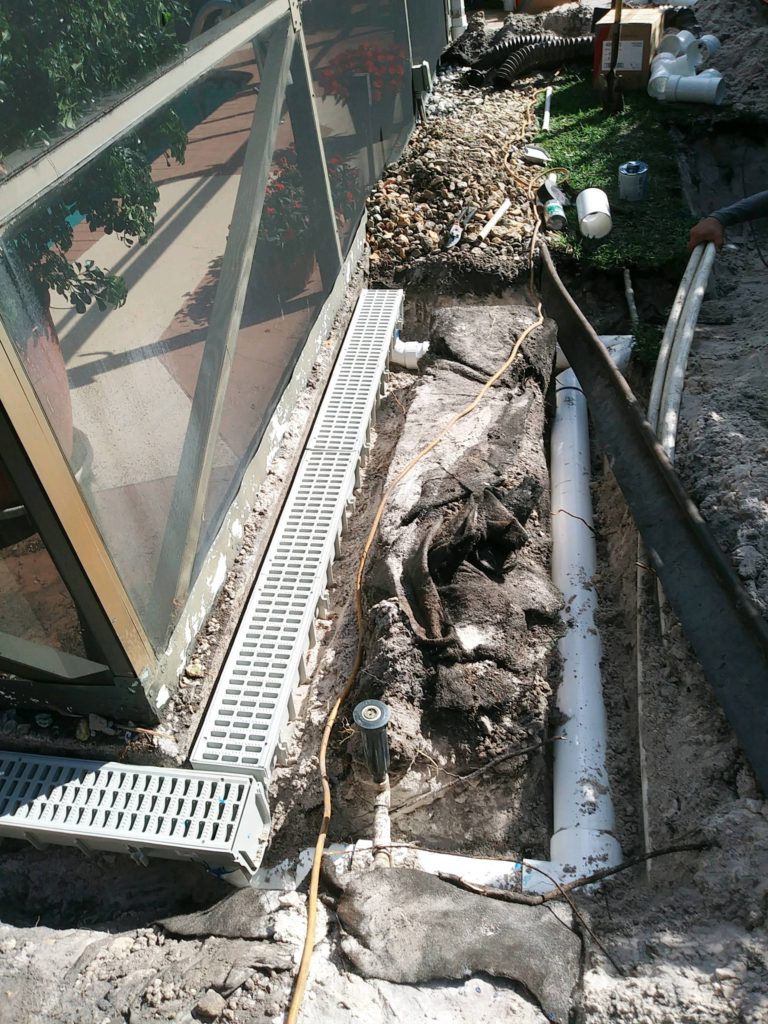
Question # 2 : How is the water going to leave the area?
First we look at the ‘French Drain’
This is an important part of every drainage project solution. Water will only move by those few main ways already mentioned. Either A) seeping into the ground B) Gravity dictating downward or downhill & C) By pressure of force.
First we’ll address the French Drain, a way to help water going into the ground. There are many misconceptions about the effectiveness of French Drains we hear. We define a French Drain as a hole in the ground that has been excavated, lined with a septic liner fabric for example and filled with stone for drainage. (see photos below)
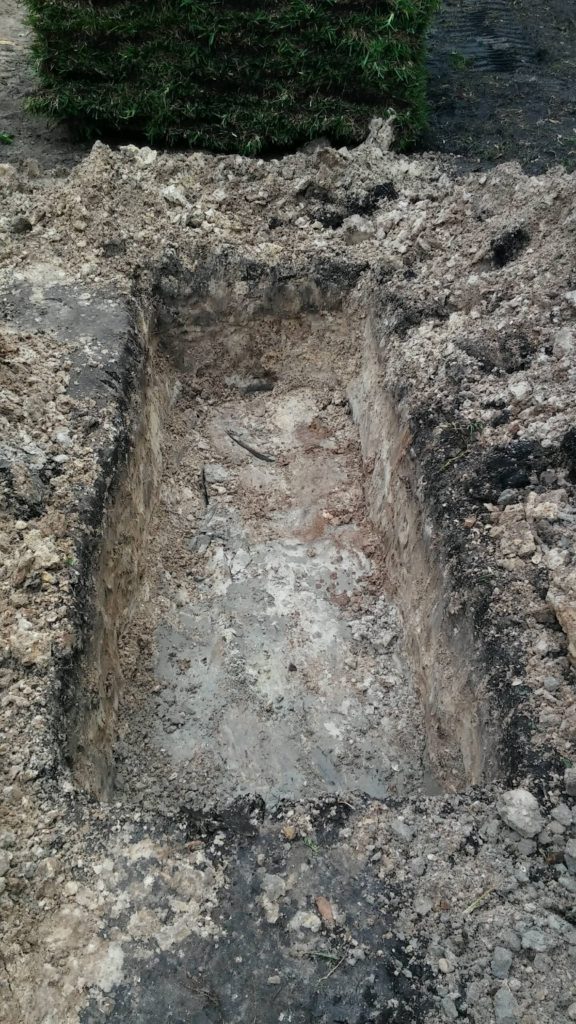
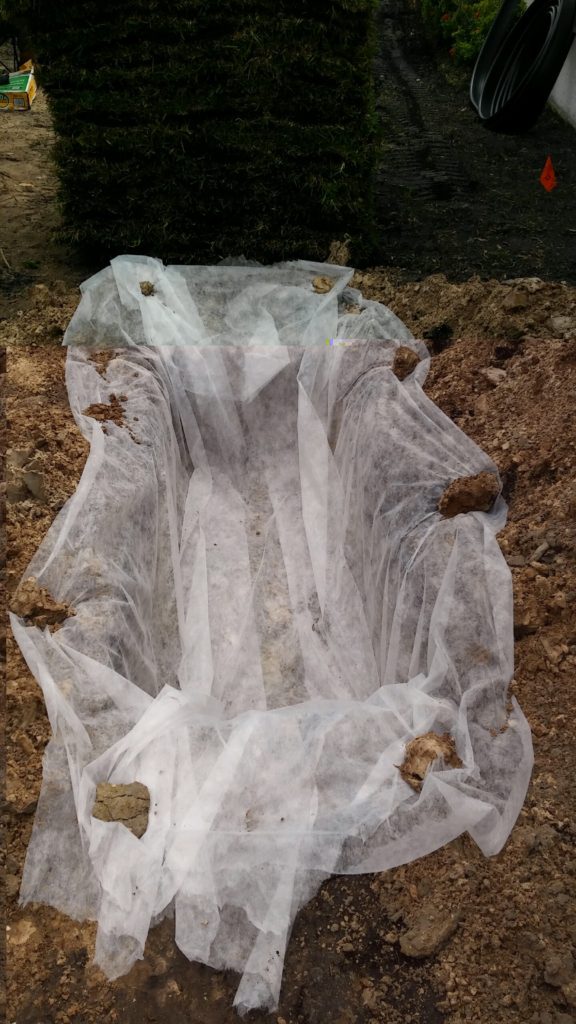
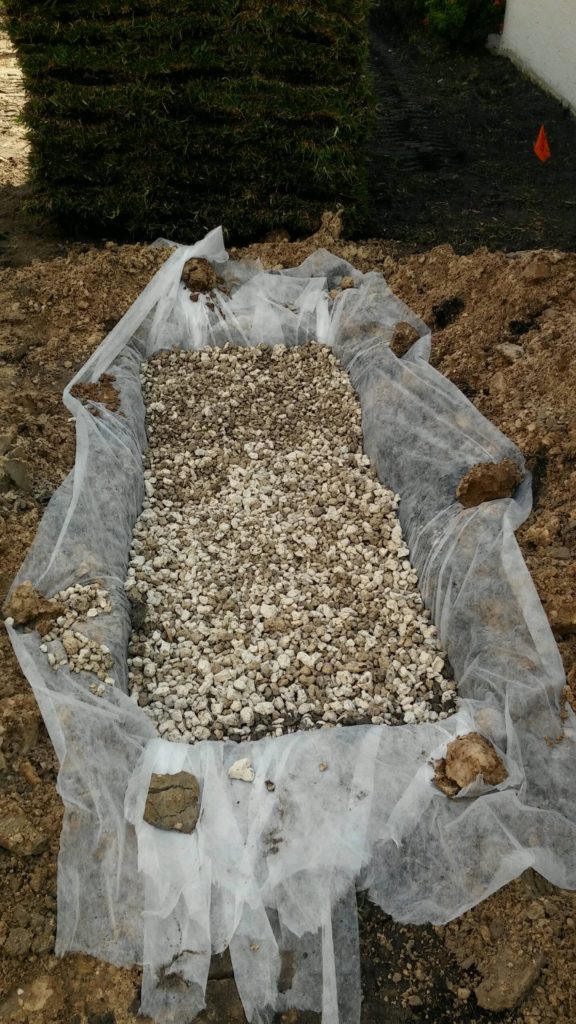
To NOTE : These French Drains are good for helping to dry out a perennially damp area, but not for larger drainage problems. There is no way to handle large volumes of water and move it away with this approach.
The French drain basin, similar to a bathtub, will only handle a limited amount of water, then it becomes full. The water will fill the basin and over time it will dissipate into the ground, but a large flow of water than comes during a storm and threatens or floods a patio or home, this is not the answer for. Again, these are best for helping to keep surface areas dry in perennially damp areas.
Underground drainage system combined with gutter downspout connections.
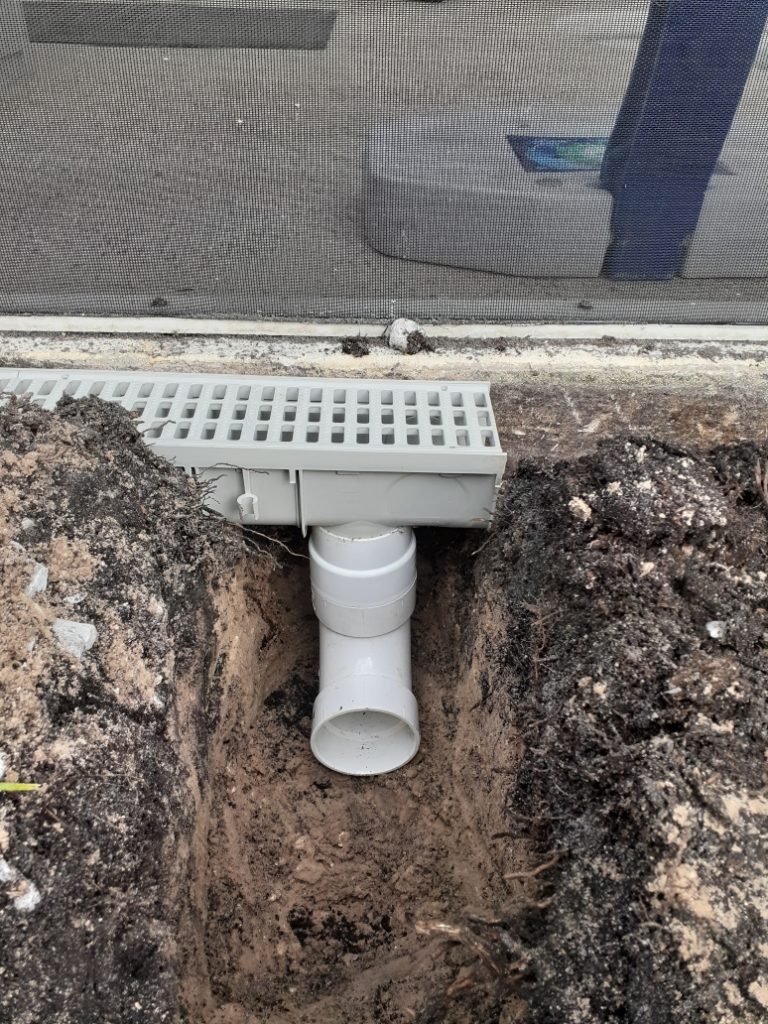
After strategically setting up the drains to best collect the accumulating water during storms, the next 2 parts of the solution here are with piping the water away and HOW THE WATER IS GOING TO BE MOVED THROUGH THE DRAINAGE PIPING AWAY.
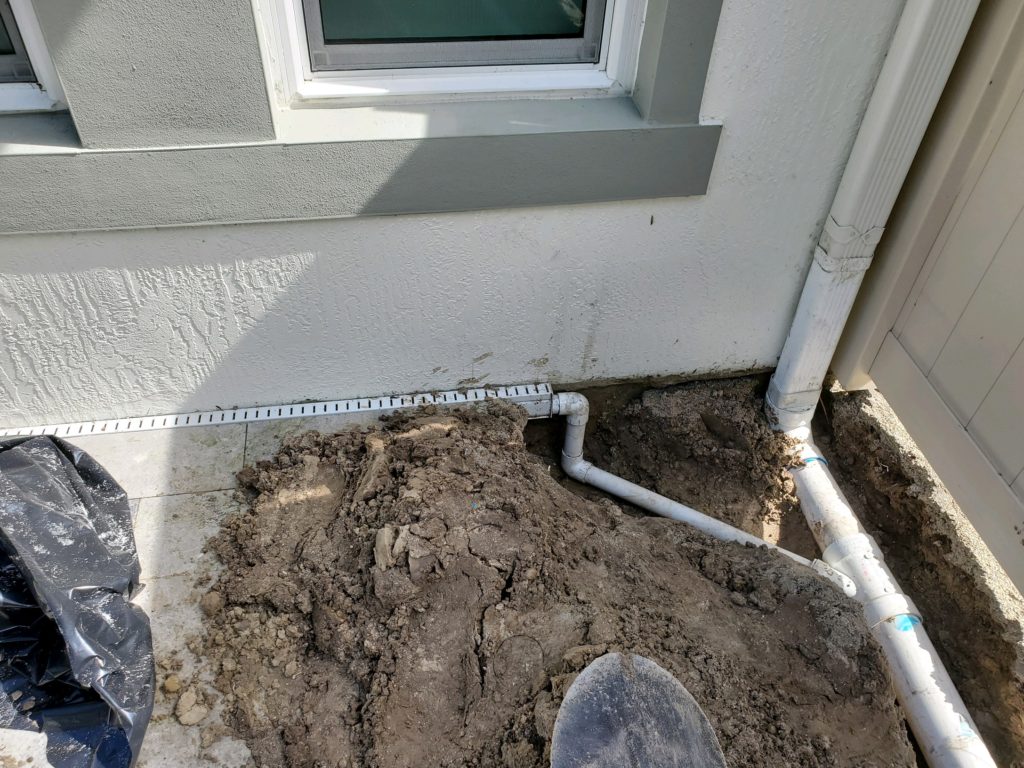
The water is pushed through the piping during a storm by the ‘head pressure’ of water rushing through the gutter downspout. In the photo above, in the top right corner you can see the gutter downspout piping as it comes down the wall of the house to the ground.
That gutter downspout is used, not by letting it flow openly on the ground or a patio, but the force of that water serves a purpose to help “push” the collected water through the underground drainage piping.
You will notice if you ever look at a gutter downspout during a storm, the harder and more forceful the rainfall, the stronger the rush of water flowing out of that gutter downspout that collects the water from the roof and channels it all to come out through those downspouts.
Even if the power goes out during a storm, natural physics still works here as water is being collected from the roof, channeled to the gutter downspouts to collect in a force of more concentrated water flowing through that downspout. That harnessing of water falling and coming out with force through the downspout during a storm is what ‘pushes’ the water through the underground drainage system.
In the worst circumstances, especially if the water has to be piped upward to get to an area of release, these PVC Drainage piping systems can be augmented if needed. If the force of the water from the house gutters is not enough, a sump pump can be added to help push water through the piping system.
This is why gutters have to be a part of this solution, without them, you will have no means of pushing the water without a sump pump.
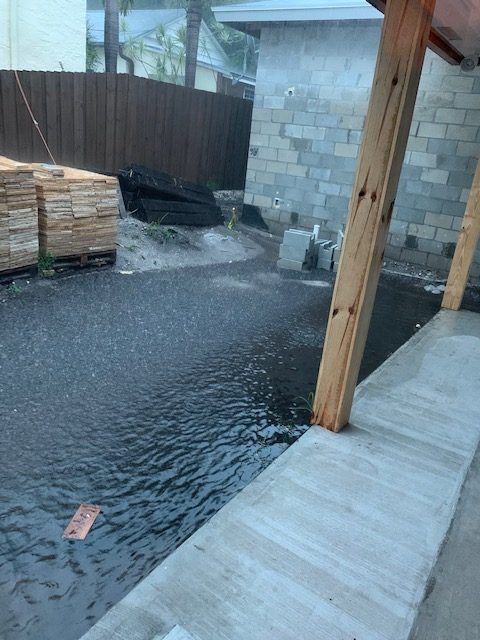
Capturing and moving the water out of an area.
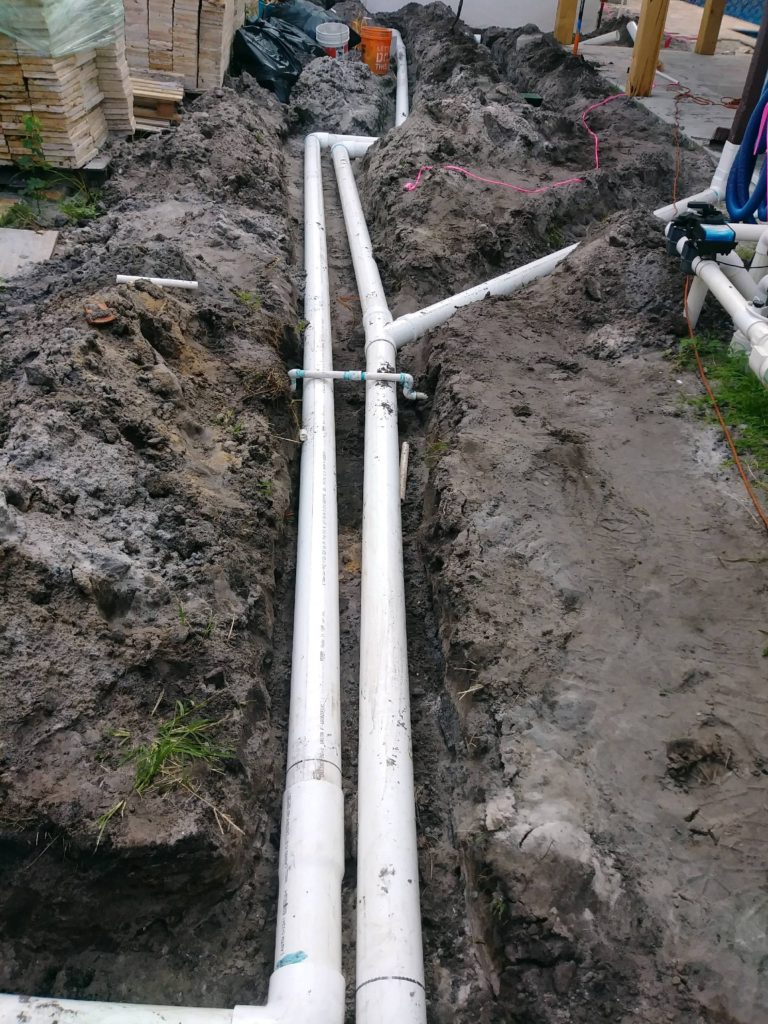
With the water moving through the drainage pipes, being pushed during heavy rain storms by the collection of water and force or ‘head pressure’ being released through the gutter downspouts, THIS IS WHAT MOVES THE WATER THROUGH THE PIPING DURING A STORM.
In the worst situations, as mentioned previously, if the grade is especially challenging or if the water actually has to go upwards on a property, a sump pump can be added to this underground drainage piping to help augment the system and help to Push it out. Automatic sump pumps can be installed with ‘floater’ arms that will accumulate in a basin the pump is installed in. As the water level increases in the basin to a point the sump pump arm raises and activates, it will turn on an push the water out until the water in that sump pump basin is lowered and the sump pump’s floater arm is no longer elevated and no longer turning on the pump. This is not typically needed in a low grade area such as south florida, but is more common up north.
3rd Question : Where is the water going to go?
While the first 2 sections cover how the water can be captured and how it can be moved, without this important 3rd part of the equation, the system won’t work.
The water that is collected needs to be able to continually flow away from the area that is having a drainage problem. If there are 3 straight days of heavy, heavy rains, for three straight days the water needs to be able to continually leave a property.
This is why the French drain is not really a solution to a serious flooding problem. A french drain is a basin, with a determined amount of water that it will hold. The bigger the basin, the more water it will hold, but for the serious longer lasting rain storms that can last over days or weeks or longer, they are not practical for continuously getting rid of larger, ongoing, volumes of accumulating water during heavier rains.
There has to be a release point that the water can leave through
The collected water that is collected from the roof of the home or building, goes down through the gutter downspouts and into the underground piping needs to keep flowing to keep up. This is also the same for any drain in the ground that is used to collect water building in an unwanted area on the ground.
The water collected needs to be able to continuously being collected and needs to be able to continuously leave during a storm.
That requires the water to have an EXIT FLOW POINT that is unobstructed and ties into a larger development’s drainage system of streets or easements. Most typically this is at the front of a property by the street.
The Water Outflow Point of the Drainage System
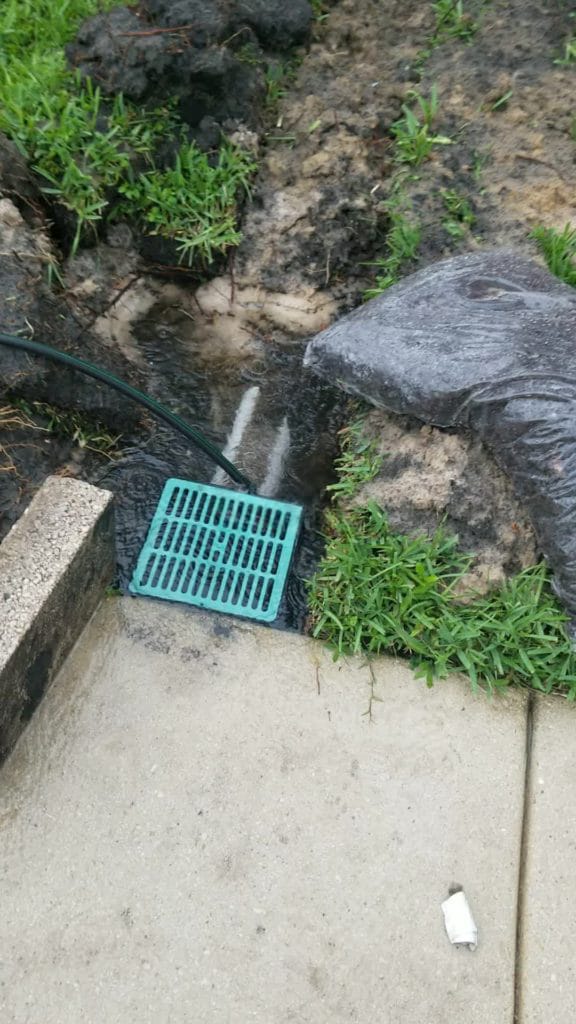
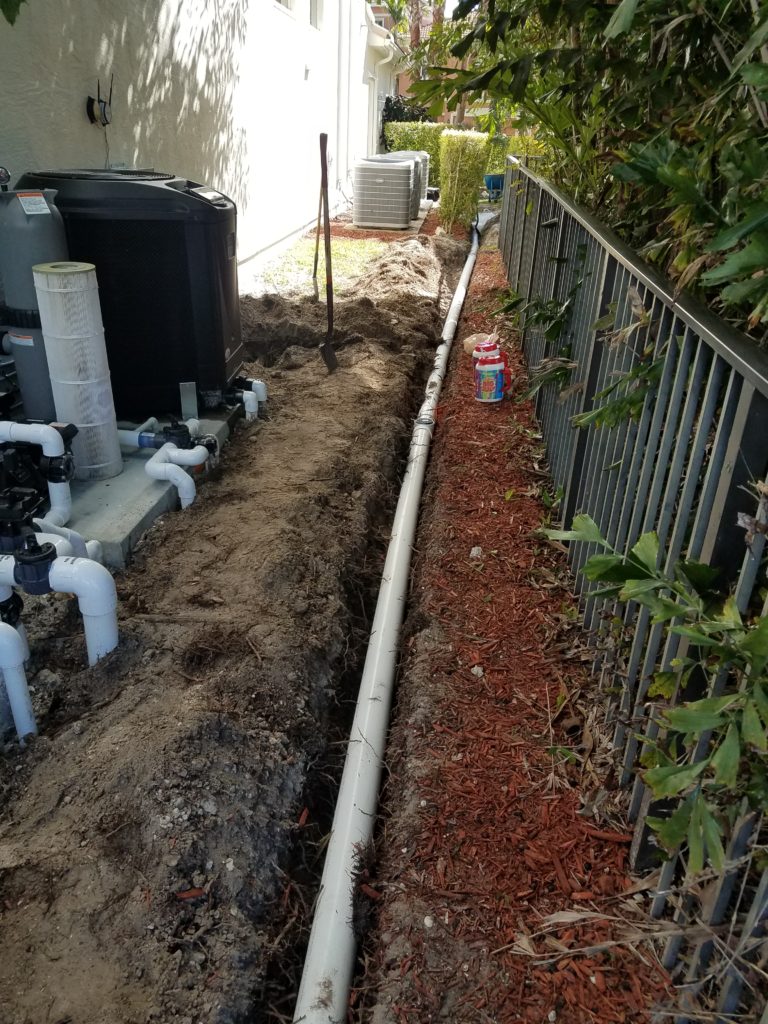
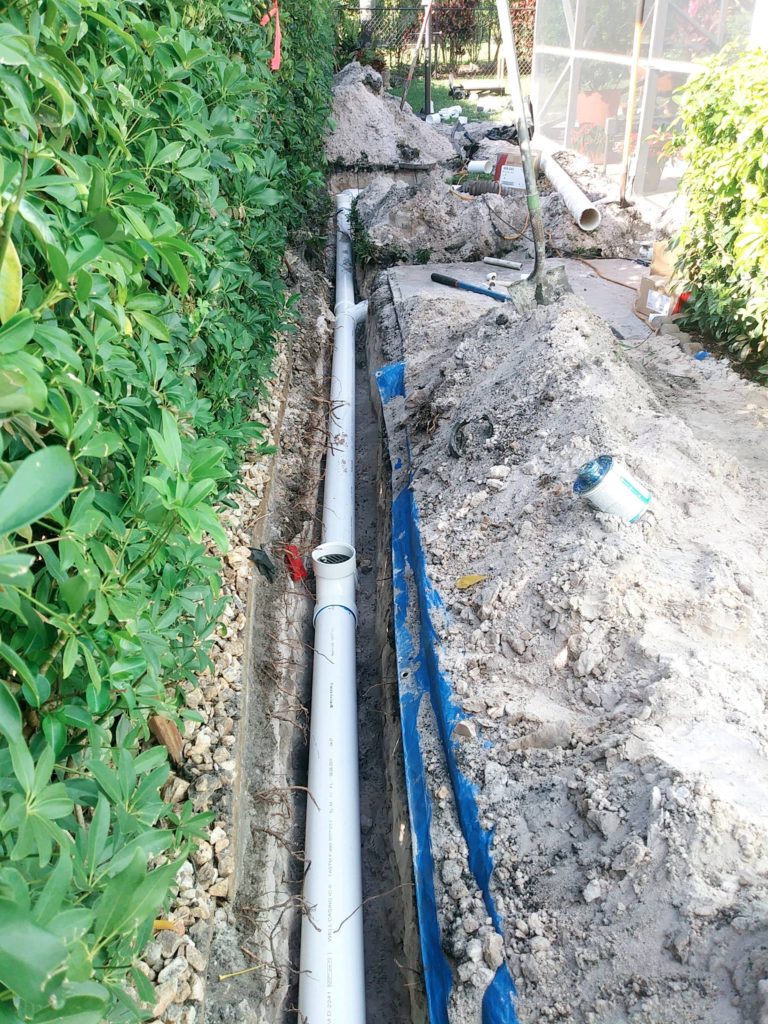
What happens to the Outflow Point during and after a storm is over?
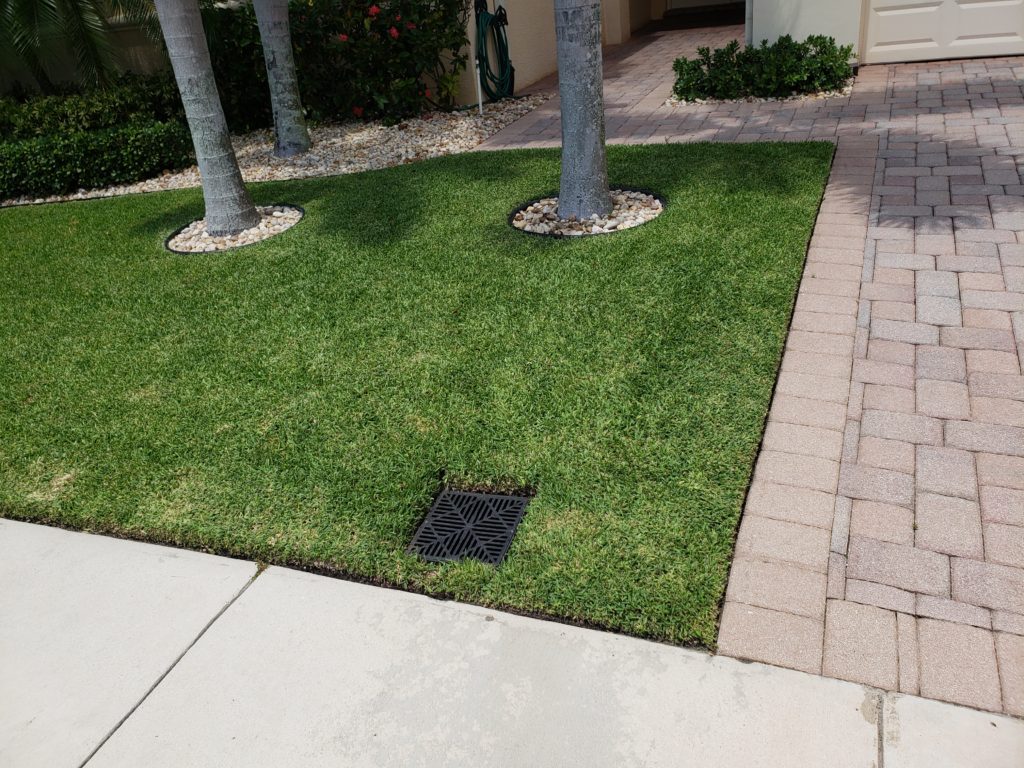
The only time an outflow point of a drainage system will look like this, dry, is when there is no rain.
During the storm, it will look as in the photo above and again below, with water flowing out of it and sitting in the area of the outflow point if the exit point is not elevated with water to roll into a lower street. The bigger the slope of a property, the quicker it will roll out of the outflow point.
The less of a slope or difference in grade between the outflow point, the more water will be seen as it some properties may be more difficult to leave the outflow point area, because again of a level or even a negative grade. The difference, better to have the water accumulate near the outflow point by a street or sidewalk, instead of the area closer to a home or building or patio area and threaten a home.
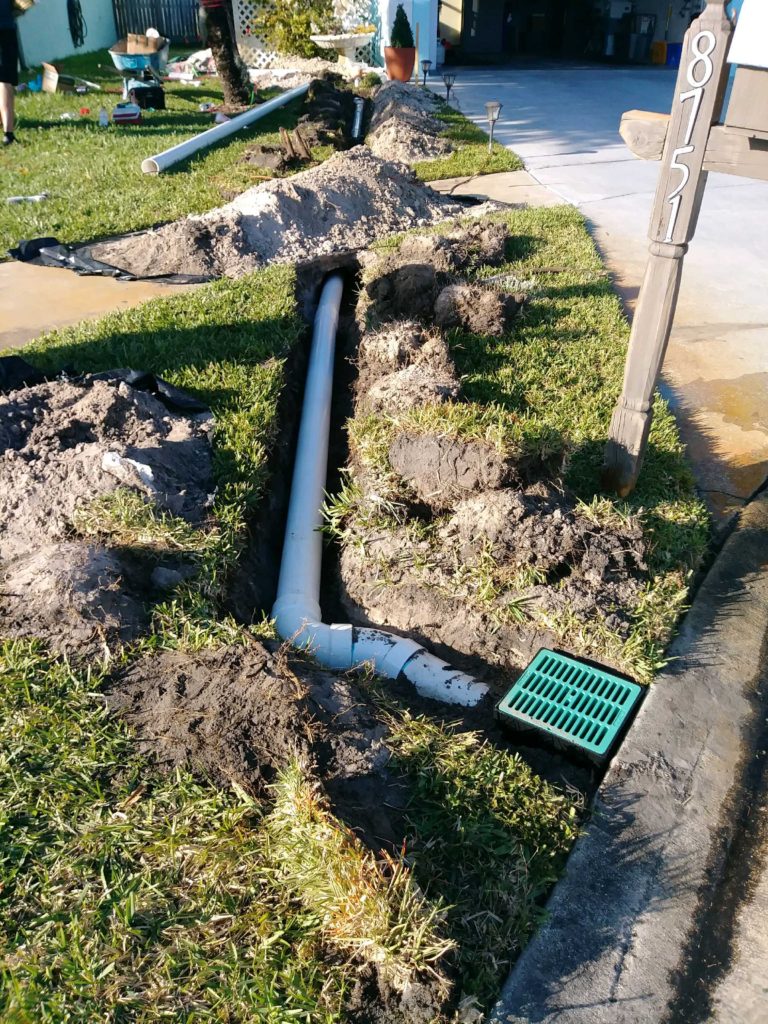
This is where the water will sit after the storm
The collection of the water through the system all leads to the outflow point. Unless your outflow point is going directly into a larger underground neighborhood or municipal piping system, which requires permitting to tap into in many cases, it is an above ground release like this photo above.
When the storm is strong, the water will flow from here strong. When the storm dissipates the “push” of the water from the gutter downspouts through the piping weakens and the water isn’t being pushed out as much as during the heavier parts of the storm.
The water will pool in the pipe and be visible in the outflow basin.
In this system there is no pump that pushes the water out of the piping unless a sump pump was needed to make the system work, so the water remains in the piping and the outflow basin, throughout the underground system until it evaporates.
This is why at the end of a storm you will see water in the outflow basin as in the photo below. Again, if you wish to clear the pipes out after a storm a sump pump can be added to the system to help do this.
Important Maintenance to Remember
Debris and silt from both the roof and the ground can be gathered and accumulate inside the drainage system. Properties with more trees may need to clear out the lines more often than those with less trees and leaves that gather on a home or building or grounds.
Besides debris & silt from the gutters that can get into the system, stones, dirt, debris can also enter and settle into the below ground piping causing these systems to stop working. If you experience the system working not as well as when installed, line blockage should be checked and cleared of any obstructions of debris, soil, sediment, etc.
To clear the lines of these systems the collection drains in the system can have the lids of the drains removed and the debris than vacuumed clear through a wet vac for smaller areas, or even taking the exit point and getting a roto rooter or septic draining company to help clear the lines through suction.
Also, keep an eye on how both the collection and ESPECIALLY THE EXIT POINT OUTFLOW DRAIN(s) of the system are kept clear. If lawns are allowed to grow over the outflow point(s) this will restrict the ability for the water to flow freely out of the system.
If anything is placed over or covering the Exit Flow point(s) of the system, this will also restrict the ability for the system to work, as both of these situations will “Plug” the system and when it can’t release water – water will back up in the property.
We recommend doing your research as you’re doing and also calling numerous companies for an estimate for comparisons and a helpful way to become more educated. If in our service area, if we can be of service it is our privilege to help and serve. If outside or within our service area, we hope that you find this information helpful and that you may benefit from it in some way.
We do many types of landscape and property renovations, some just call for drainage work, which is never a happy situation. In the many project photos of our website here which we hope you might enjoy, knowing about how to help get water out of an area is a natural part of the challenge through the decades we’ve encountered in truly transforming areas.
Again, we hope that our work and effort here helps make a difference and a well thought out plan that works right, the first time. And to do so, each of the basic questions in any solution, that we’ve mentioned here should be answered.



